 |
| Recent satellite imagery of Russia's massive Project 23900 amphibious assault ship, the Ivan Rogov, at the Zaliv Shipyard in Russian-occupied Kerch, Crimea. |
April 7, 2025
Black Sea Naval Power Projection Takes Shape Despite Sanctions
Recent satellite imagery has revealed significant progress in the construction of Russia's massive Project 23900 amphibious assault ship, the Ivan Rogov, at the Zaliv Shipyard in Russian-occupied Kerch, Crimea. This vessel, part of Russia's most ambitious naval project in decades, represents a major expansion of Moscow's maritime capabilities in the Black Sea region.
Satellite images from spring 2025 show substantial advancement in the vessel's construction compared to July 2024, when its hull was still in early assembly stages. Russian engineers have made notable progress in under a year, though the vessel remains far from completion.
The Ivan Rogov class ships will be the largest warships ever built for Russia's navy. Each vessel is designed with impressive capabilities, including capacity for up to 15 helicopters (primarily Ka-29 transport/attack and Ka-52K assault helicopters). With a length of approximately 220 meters and width of 40 meters, the ship will have a displacement of around 30,000 tons - nearly three times larger than the 11,490-ton cruiser Moskva, which was the Black Sea Fleet's flagship before being sunk by Ukrainian forces in 2022.
Replacement for Canceled French Mistral Deal
The Project 23900 vessels were developed as Russia's domestic replacement for the French-built Mistral-class amphibious assault ships, which Moscow had initially intended to acquire before France canceled the deal in 2014 following Russia's annexation of Crimea. A contract for two Project 23900 ships was signed in May 2020, with construction led by JSC Zelenodolsk Design Bureau, part of JSC Ak Bars Shipbuilding Corporation.
The vessels were officially named Ivan Rogov and Mitrofan Moskalenko during a keel-laying ceremony on July 20, 2020 - the same names as two already decommissioned Soviet-era Ivan Rogov-class vessels.
Strategic Implications
These vessels represent a significant leap in Russia's amphibious warfare capabilities. Its ability to deploy marines and helicopters would enhance Moscow's capacity to threaten coastal targets or reinforce positions in contested areas like Crimea. The vessel could also serve as a mobile command center for expeditions in the Arctic or Mediterranean, aligning with President Vladimir Putin's vision of reviving Russia's global military reach.
Each ship is designed to transport up to 900 marines, 75 pieces of combat equipment, and three smaller landing craft, in addition to its helicopter complement. According to reports from 2021, the ships will also have the capacity to carry and launch advanced Sukhoi S-70 Okhotnik-B drones.
Delays and Challenges
Despite the progress, the project faces significant challenges. The first ship, Ivan Rogov, was originally scheduled to enter the Russian Navy by 2025, but sea trials have been postponed to at least 2027, with analysts expressing pessimism about meeting even this extended timeline. Current projections suggest the ship will be ready for factory and sea trials by the end of 2027, with delivery to the Russian Navy in Q3 2028.
The ambitious timeline and capabilities are clouded by Russia's economic challenges and international sanctions, raising doubts about the project's timely completion and operational readiness. The fate of the second ship in the class, Mitrofan Moskalenko, remains unclear, with no significant updates on its construction progress.
Security Considerations
The decision to build such a high-profile asset valued at hundreds of millions of dollars in Crimea carries significant risks. A Ukrainian cruise missile attack on the Zaliv shipyard in November 2023 left a Russian Navy Karakurt-class corvette severely damaged.
Even if commissioned, Ivan Rogov is unlikely to operate near the front lines. Given Ukraine's proven ability to target and destroy high-value Russian naval assets, Moscow may choose to keep the vessel stationed in Novorossiysk, Russia's safest naval base in the Black Sea.
Conclusion
Despite setbacks and delays, Russia appears committed to completing at least one of its Project 23900 assault ships, which would mark a major naval expansion in the Black Sea. Whether these ambitious vessels will be completed as scheduled - or if they will remain another delayed project in Russia's struggling defense industry - remains to be seen amid ongoing economic challenges, supply chain disruptions, and the continuing war in Ukraine.
Sources:
- Project 23900 amphibious assault ship - Wikipedia
- Russia Races to Build Ivan Rogov, Its Largest Black Sea Warship, in Occupied Crimea | UNITED24 Media
- Russians Build Ivan Rogov Amphibious Assault Ship in Temporarily Occupied Crimea (Satellite Images) | Defense Express
- Russia completing Ivan Rogov amphibious assault ship in Kerch, satellite images reveal / The New Voice of Ukraine
- Russia's Project 23900 Amphibious Assault Ships: Mini Aircraft Carriers? - The National Interest
- Russia Speeds Up Construction of Its Largest Ship With 15 Helipads | Defense Express
- Satellite Images Reportedly Show Russia's Huge New Black Sea Flagship - Newsweek
- Russia's New Helicopter Carrier Is Taking Shape In Crimea
- Russian Ivan Rogov warship defies sanctions in rapid build
- Russia's Project 23900 LHD Model Unveiled by USC - Naval News
Russia's New Helicopter Carrier Is Taking Shape In Crimea
Satellite imagery shows work on the first of Russia’s Project 23900 big-deck amphibious assault ships, also known as the Ivan Rogov class, is continuing at a shipyard on the occupied Crimean Peninsula. Ukrainian forces have targeted the Zaliv yard in the past, severely damaging at least one warship.
Ukrainian outlet Defense Express called new attention to the ongoing work on the initial Ivan Rogov class ship at Zaliv yesterday, publishing a satellite image from an unspecified source it said had been taken in “spring 2025.” TWZ subsequently obtained another image from Maxar Technologies, seen at the top of this story and uncropped later on, which was captured on Nov. 17, 2024, and also highlights the progress that has been made in the past year or so. Russia has two Project 23900s on order, currently set to be named Ivan Rogov and Mitrofan Moskalenko, and a keel-laying ceremony was held at Zaliv back in 2020.
The image from Maxar and the one Defense Express obtained both show the Project 23900 amphibious assault ship very much still under construction. At the same time, the hull is dramatically more complete than it was in 2023 or even by the middle of the following year. Two large rectangular gaps are now visible, which could be for elevators to move aircraft and other materiel between the flight deck and below-deck hangars. The ship still lacks its flight deck and island.
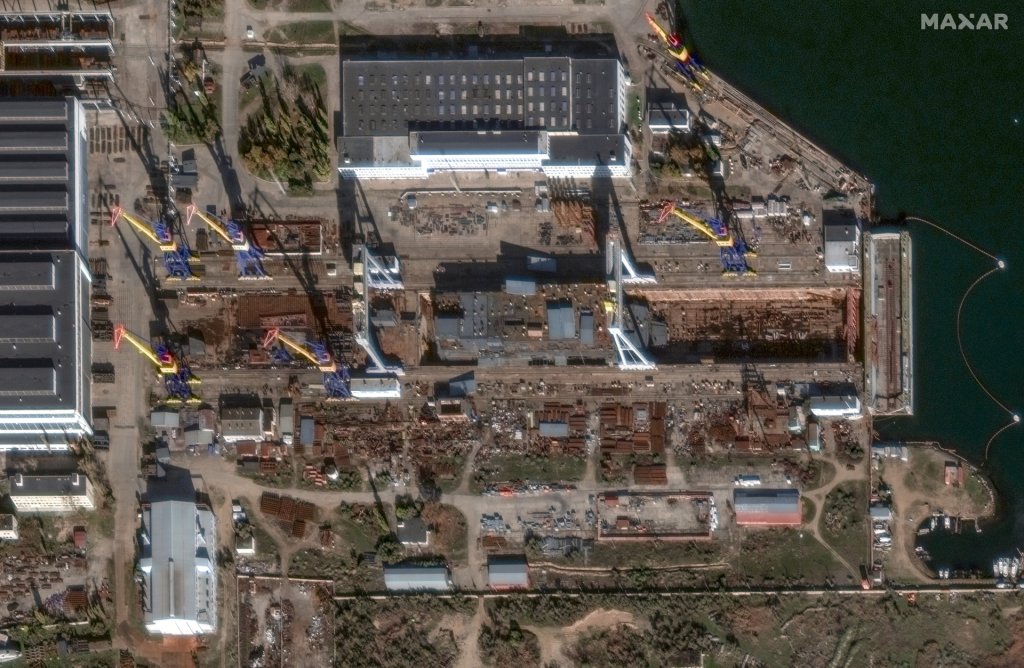
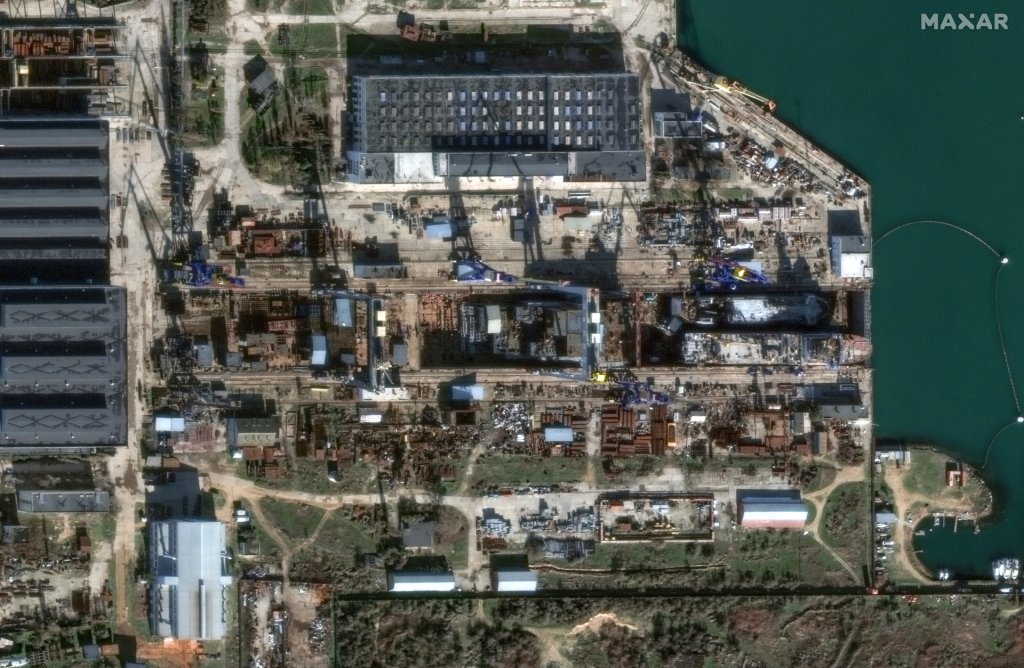
Defense Express estimated the ship to be just under 722 feet (220 meters) long and just over 131 feet (40 meters) wide based on what can be seen in the image it published. This is in line with details on the ship’s dimensions in a 2021 report from Russia’s state-run TASS, which also said that the Ivan Rogov class design would have a draft of close to 23 feet (seven meters) and a speed of up to 24 knots. Past reports have said that the Project 23900 could have a displacement of 30,000 or 44,000 tons, either of which would put it at the high end of ships this type globally. For example, the U.S. Navy’s America class also displaces close to 44,000 tons when fully loaded. It’s unclear whether either displacement figure, as well as the expected draft, reflects the Russian ship with or without a typical combat load.
Previous reporting has also said the Project 23900s could possibly carry up to 16 helicopters, as well as six landing craft (launched and recovered via a well deck at the stern), 75 vehicles, 900 troops, and additional materiel to support amphibious operations. Official models and renderings have shown Ka-27/29-series anti-submarine warfare/armed utility and Ka-52-series attack helicopters on the deck, but the ships could potentially accommodate other types. The possibility of Russia developing a new short and/or vertical takeoff and landing capable fixed-wing combat jets to go with the Project 23900s has been raised, but there is no evidence to date of actual work on such a design. There is also a growing trend to add drones to the air wings aboard big-deck amphibious assault ships, or at least exploring doing so, globally.
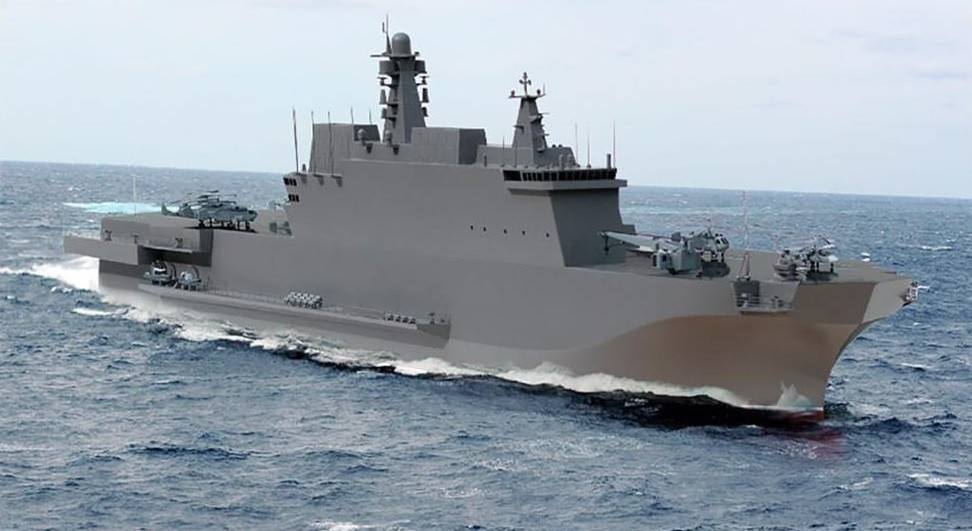
Though work on the Ivan Rogov class predates Russia’s all-out invasion of Ukraine in 2022, its origins are directly tied to the latter country. In 2011, the French government approved the sale of two Mistral class amphibious assault ships to Russia, a deal that was scrapped after the seizure of Crimea in 2014. The two Mistral class ships originally under construction for Russia were subsequently sold to Egypt. The Project 23900 ships are intended to fill the resulting gap.
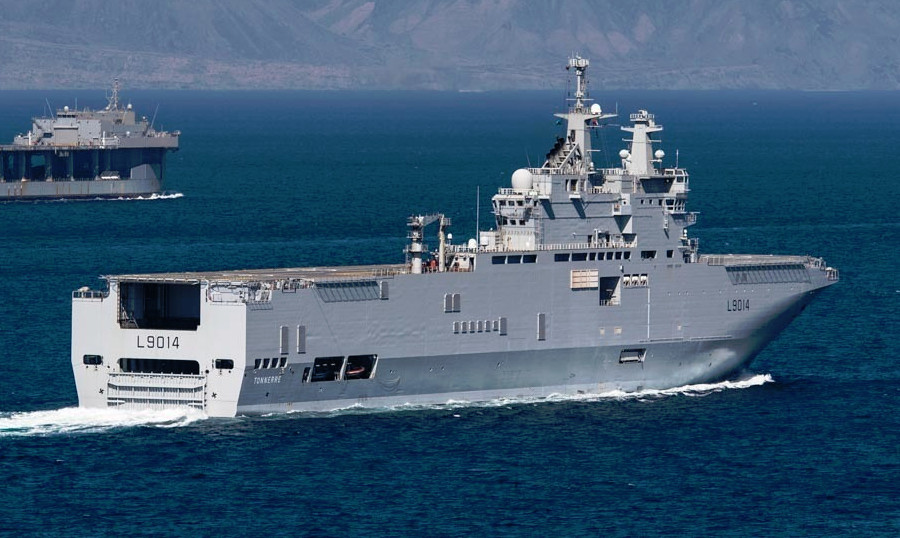
Zaliv’s continued work on the Ivan Rogov class ship now highlights additional issues, not least of which are the risks associated with building such a high-profile asset valued at hundreds of millions of dollars in Crimea. A Ukrainian cruise missile attack on the shipyard in November 2023 left the Russian Navy’s Project 22800 Karakurt class corvette Askold severely damaged. Ukrainian forces have launched cruise and ballistic missiles, kamikaze drones, and drone boats against ships and submarines in port (as well as vessels sailing out in the Black Sea) and other targets elsewhere across Crimea in the past. Ukrainian attacks on targets in Crimea, especially ones involving longer-range munitions, have slowed in recent months. Russia has also been working to step up its air, missile, and other defenses on the peninsula.
It is somewhat curious that Ukrainians have not targeted the incomplete Ivan Rogov class ship already. One factor could be that there is greater demand for the resources required to strike a vessel that still looks to be far away from being put in the water, let alone entering operational service any time soon. At the same time, even just setting back work on the first Ivan Rogov class ship would have real ramifications for the Russian Navy, as well as offer propaganda and morale-boosting benefits for Ukraine.
The fact that Zaliv is building the Project 23900s at all also underscores the immense value of the warm water port facilities in Crimea to the Kremlin. All four of the Soviet Union’s Kiev class aircraft carriers, as well as the Admiral Kuznetosv (and its unfinished sister ship that was eventually completed in China as the Liaoning), were built in Ukrainian shipyards. Plans to further expand the facilities at Zaliv in Crimea were announced in 2021.
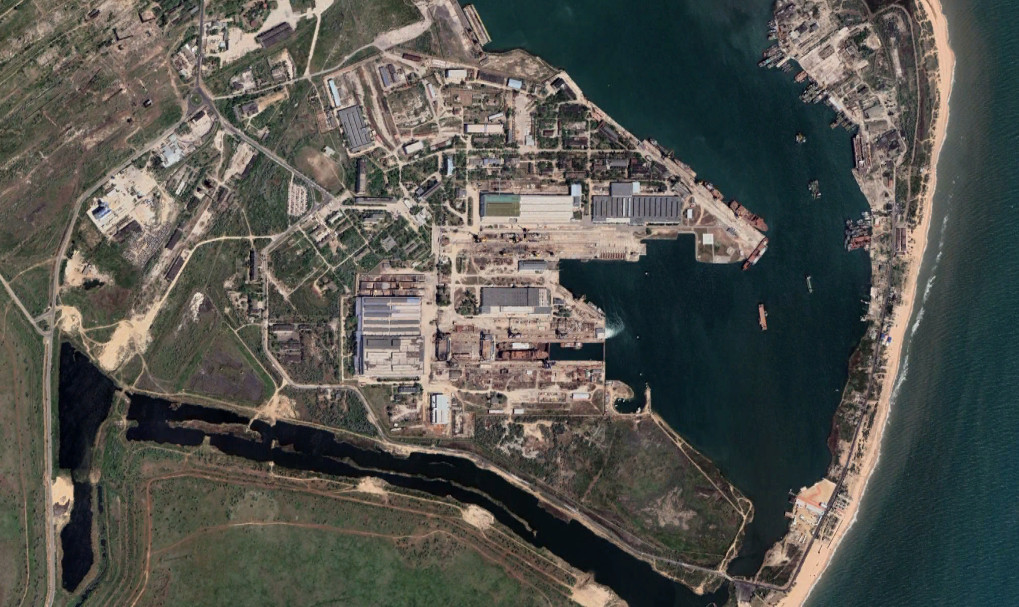
Maintaining large surface ships is also a challenge for the Russian Navy. After the only floating dry dock Russia had that was big enough to accommodate Kuznetosv sank in an accident in 2018, a dry dock at the Sevmorput Naval Shipyard had to be greatly expanded. Though it is back in the water now, when the carrier might return to the fleet is still very much an open question.
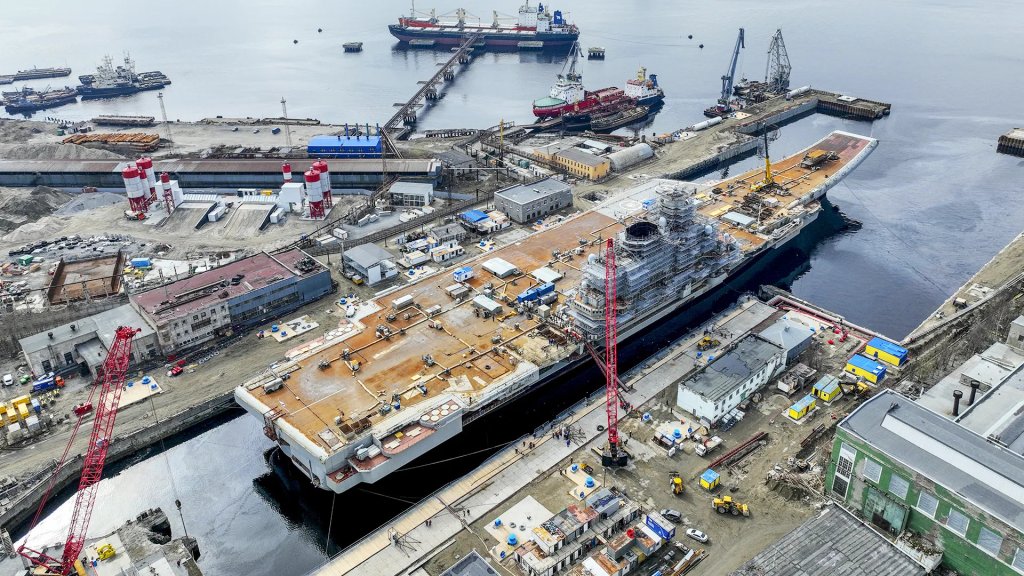
Even if the Kuznetosv ultimately returns to service, the addition of two new big-deck amphibious assault ships would give the Russian Navy an important capability boost in multiple arenas. As TWZ has previously written:
“Ultimately, an amphibious assault ship is potentially much more flexible, even without conventional fixed-wing airpower. The Project 23900 is expected to be able to embark six landing craft to transport around 75 armored vehicles, 900 troops, and support equipment to a beachhead during an amphibious operation, but the vessels would also be suitable for floating hospitals or as flagships for littoral operations. With some modifications, or with a tailored air group onboard, these warships could also take on anti-submarine or mine warfare roles. In addition, time and again, amphibious vessels of this kind have also shown their worth in non-combat scenarios, including disaster relief and humanitarian assistance missions.”
As it stands now, the first Ivan Rogov class ship is not expected to be completed until 2027, two years later then originally planned. Even without any disruption to that work from the ongoing conflict in Ukraine, it remains to be seen if Zaliv can keep to that schedule. Crippling U.S. and other international sanctions imposed on Russia after the invasion of Ukraine have had significant impacts on the country’s defense and shipbuilding industries, among others. The U.S. government and the European Union have both sanctioned Zaliv explicitly.
What is clear is that work on the first Ivan Rogov class amphibious assault ship is still underway in Russian-occupied Crimea, despite the potential risks and other issues.
Contact the author: joe@twz.com


No comments:
Post a Comment